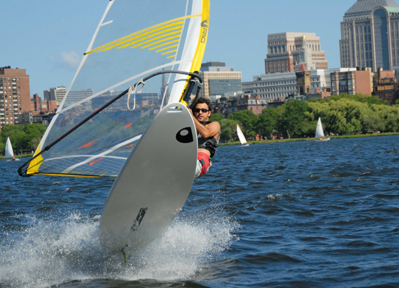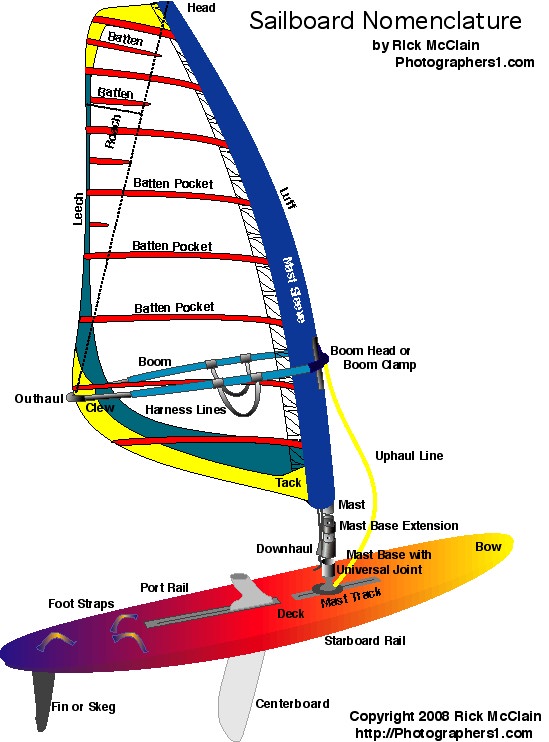Support the sailing program!
Reserve the Pavilion
Upcoming Events
Mon 6 January
Tue 7 January
Thu 9 January
Tue 14 January
Thu 16 January
Latest Results
Windsurfing @ MIT
The Sailing Pavilion at MIT hosts a windsurfing group with very diverse skill levels and experience. Everyone who surfs is very friendly, and willing to help whether you are just getting started, or are advancing to intermediate techniques. We also make occasional trips to nearby windsurfing destinations along the coast.
The Sailing Pavilion has boards, sails, and equipment, for all of MITNA Members, There is on-dock storage, which makes coming to surf easy and convenient.
Introduction to Windsurfing Classes
Class size limited to 8 people, please pre-register.

Ratings
In order to take out the sailboards you must have:
- Swim rating
- Provisional rating
- Board surfing rating
There are three levels of board surfing ratings:
-
Board Sailing Class:
Received upon completion of the Intro to Windsurfing Class. Familiar with rigging equipment correctly and some very elementary windsurfing. Tether recommended and check in with dock staff before departing dock. -
Board Sailing Basic:
Can setup beginner equipment properly, tack, and sail upwind in light to medium wind conditions (less than 15 knots). -
Board Sailing Advanced:
Can rig shaped (advanced) sails properly, and tack, jibe, and sail upwind in strong wind conditions (more than 15 knots) with harness.
Classes
The windsurfing group hosts the Introduction to Windsurfing classes to introduce beginners into this exciting sport. These classes are about two hours long and concentrate on rigging a windsurf and general rig handling.
Rules & Guidelines
- Beginners and strong wind conditions: check in with dock-staff to see whether your skills meet the requirements for safe sailing in current wind conditions
- Dock-staff may ask you to tie yourself to the dock with a buoy-rope (do not use a rope without buoys)
- You may ask whether staff has time to help you
- You must always wear a lifejacket when windsurfing
- The space in front of bay 4 is reserved for windsurfing. Keep all equipment in this region. Please move your board to this region so that you are not in the way of other sailors. If there are tech dinghies on the dock, speak with the dock staff and get the techs moved to another region.
- Hang the back fin of the board over the dock ONLY when launching and landing. Please haul equipment away from the dock’s edge, past the hinge in the floating dock, when not in use.
- Do NOT sail into regattas. If there is a race going on, please stay away from the racing zone.
- Stay away from the yacht club boats and bridges. If you get stuck there, swim the boards away from the yachts.
- Make sure to put gear away and roll up the sail starting from the top/head. Thus, the next person will be able to read the sail specifications.
Windsurfing Courtesy
- Watch out for other windsurfers: help less experienced sailors to rig properly and inform dock-staff if other sailors seem unable to make their way back to the dock.
- Take turns on busy days. Watch out for other people that may be waiting at the bay and offer sharing your rig! Nobody wants to wait two hours for gear to become available.
Contact
To learn more, and to get involved, join the mailing list:
Inventory
- Boards : 4
- Rigs : 1x7.5, 1x6.5, 2x5.5, 1x4.5, 1x3.0
- There are also some harnesses and harness straps available.
How to Rig
- Find mast and boom requirements that are printed on the foot of the sail (units are in centimeters)
- Locate corresponding mast,boom, and base with mast extension
- Use short mast extension on ≤ 430 cm masts and long extension on ≥ 460 cm masts
- Adjust the metal ring and metal or plastic collar to the required amount of mast extension (typically listed as base on sails)
- Ensure that the mast to base/mast extension fit is snug (do not use an extension without the collar, since this would result in mast damage)
- Insert the mast into the mast sleeve of the sail using the hand-over-hand technique (do not push forcibly)
- Thread the downhaul line through the pulleys while ensuring that there are no cross-overs
- Apply enough downhaul tension to release the battens from the mast and cleat off the downhaul line
- Put on the boom (adjust the size of the boom to match the sail – it should not extend much beyond the sail)
- Loop the uphaul line around the foot of the mast
- Connect the rigged sail to the universal joint on the board
The parts of a windsurf rig
The following image from Rick McClain Nautical Sailing Terms & Nomenclature shows all the parts of a windsurfing rig:

